In-Depth Critique: Examining Leadership Theories in Business Ethics
VerifiedAdded on 2023/04/19
|10
|3125
|406
Essay
AI Summary
This essay presents a critical analysis of two journal articles focusing on leadership: one by Gandolfi and Stone on leadership styles and servant leadership, and another by Levine and Boaks on ethics in leadership. The critique examines the theories, values, and assumptions underpinning each article, supported by relevant literature and examples from personal work experiences. It discusses the importance of servant leadership in modern organizations, its potential to increase employee engagement, and its limitations concerning ethical considerations. The analysis also explores the connection between leadership and ethics, highlighting the need for a balanced approach that considers both organizational goals and the moral values of followers. The essay concludes by emphasizing the significance of ethical leadership in fostering trust and achieving long-term success in organizations.
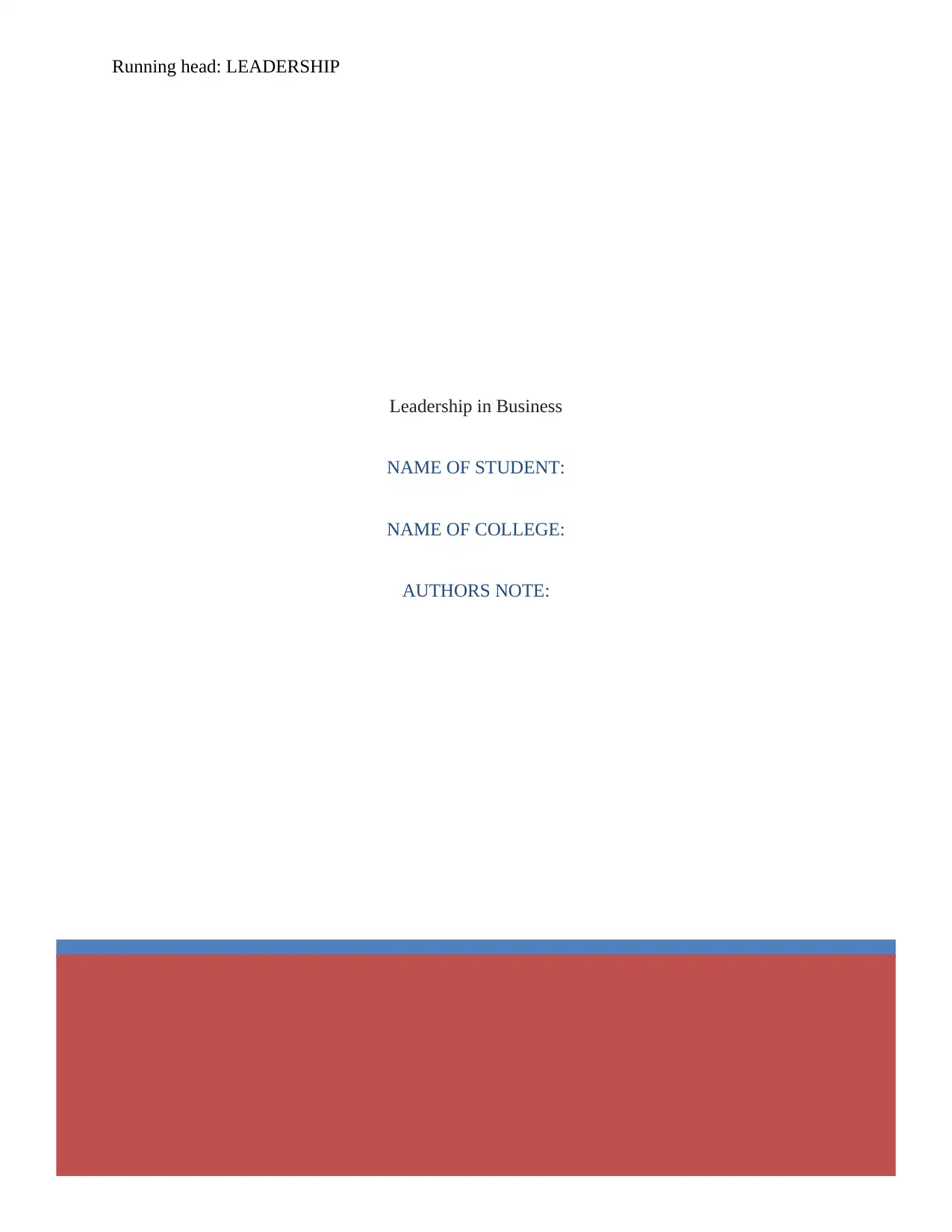
Leadership in Business
NAME OF STUDENT:
NAME OF COLLEGE:
AUTHORS NOTE:
Running head: LEADERSHIP
NAME OF STUDENT:
NAME OF COLLEGE:
AUTHORS NOTE:
Running head: LEADERSHIP
Paraphrase This Document
Need a fresh take? Get an instant paraphrase of this document with our AI Paraphraser
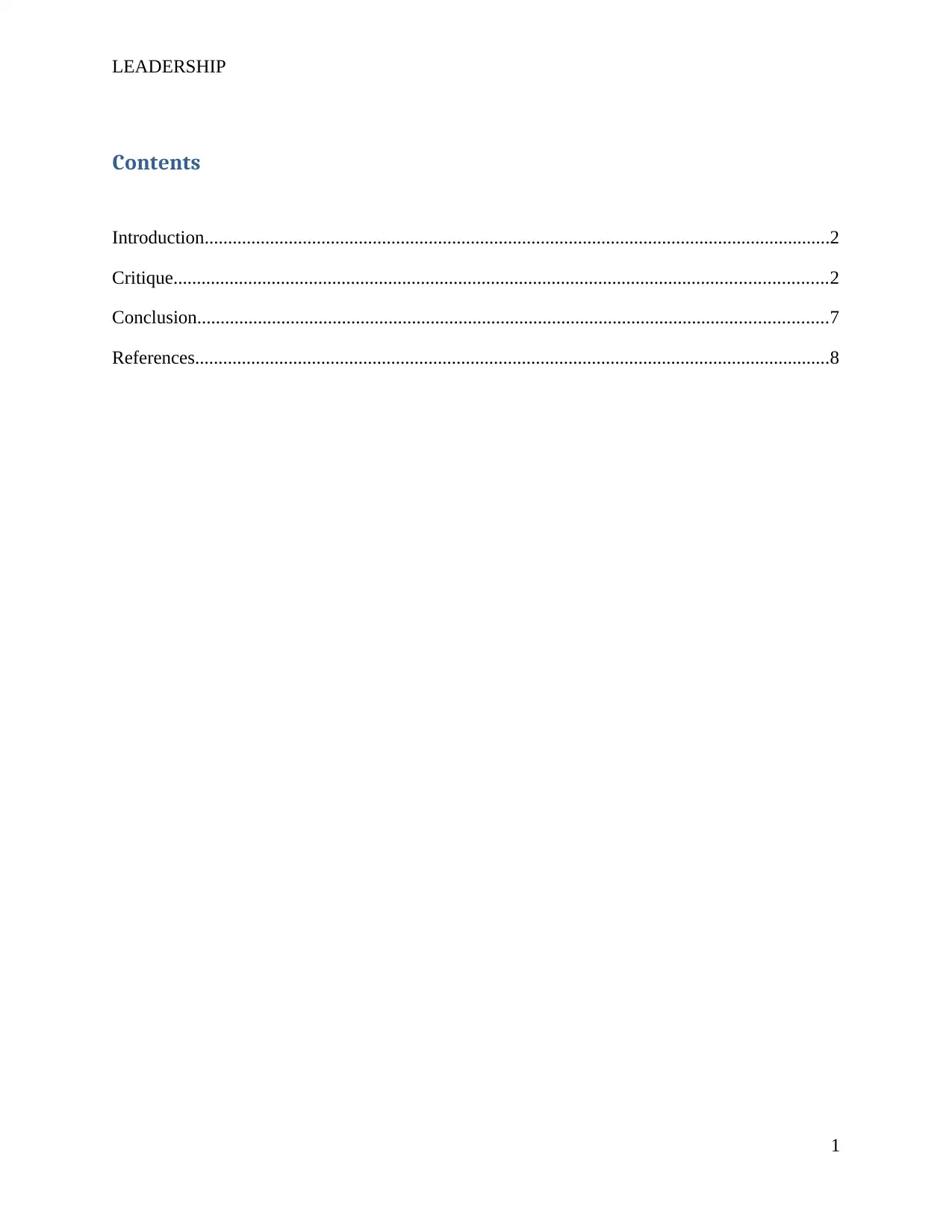
LEADERSHIP
Contents
Introduction......................................................................................................................................2
Critique............................................................................................................................................2
Conclusion.......................................................................................................................................7
References........................................................................................................................................8
1
Contents
Introduction......................................................................................................................................2
Critique............................................................................................................................................2
Conclusion.......................................................................................................................................7
References........................................................................................................................................8
1
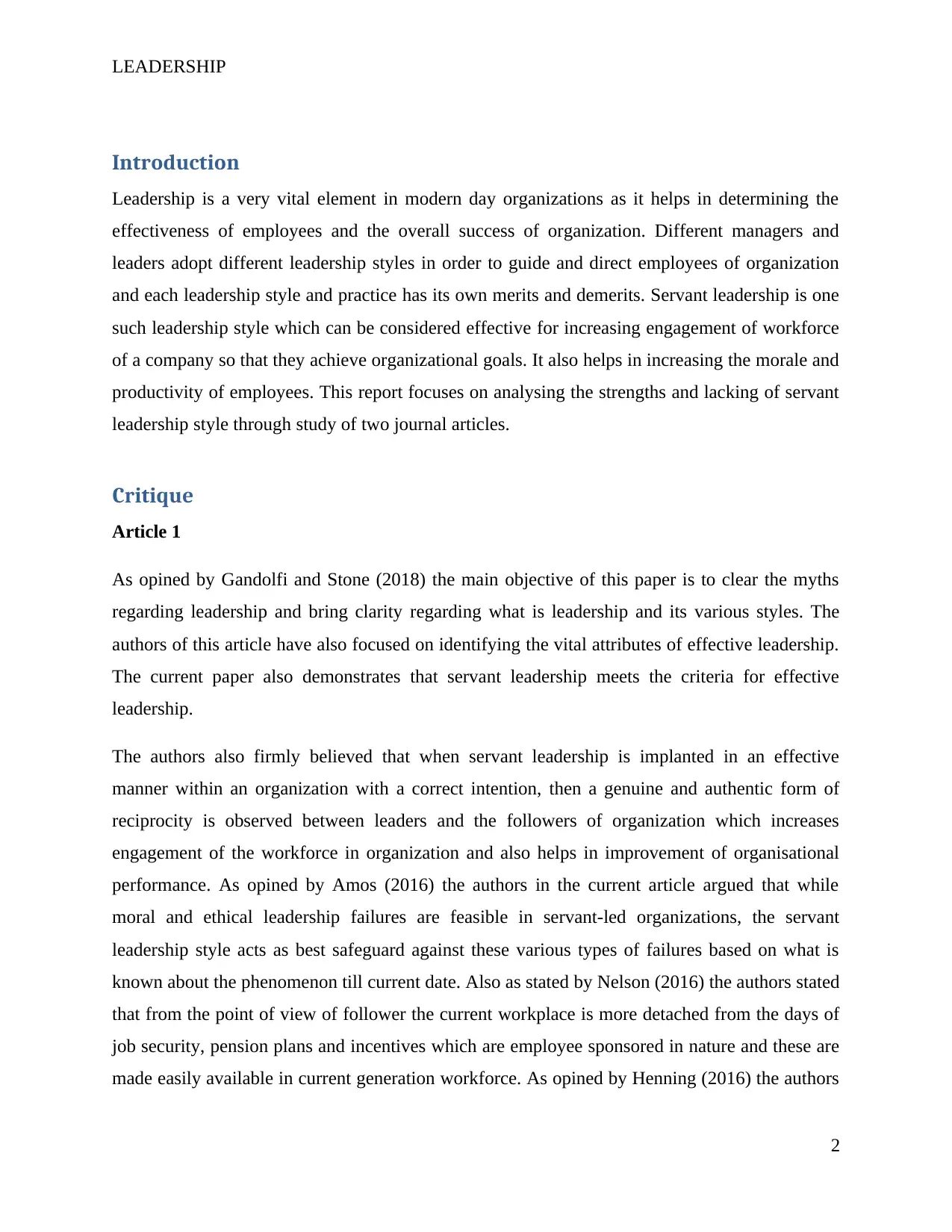
LEADERSHIP
Introduction
Leadership is a very vital element in modern day organizations as it helps in determining the
effectiveness of employees and the overall success of organization. Different managers and
leaders adopt different leadership styles in order to guide and direct employees of organization
and each leadership style and practice has its own merits and demerits. Servant leadership is one
such leadership style which can be considered effective for increasing engagement of workforce
of a company so that they achieve organizational goals. It also helps in increasing the morale and
productivity of employees. This report focuses on analysing the strengths and lacking of servant
leadership style through study of two journal articles.
Critique
Article 1
As opined by Gandolfi and Stone (2018) the main objective of this paper is to clear the myths
regarding leadership and bring clarity regarding what is leadership and its various styles. The
authors of this article have also focused on identifying the vital attributes of effective leadership.
The current paper also demonstrates that servant leadership meets the criteria for effective
leadership.
The authors also firmly believed that when servant leadership is implanted in an effective
manner within an organization with a correct intention, then a genuine and authentic form of
reciprocity is observed between leaders and the followers of organization which increases
engagement of the workforce in organization and also helps in improvement of organisational
performance. As opined by Amos (2016) the authors in the current article argued that while
moral and ethical leadership failures are feasible in servant-led organizations, the servant
leadership style acts as best safeguard against these various types of failures based on what is
known about the phenomenon till current date. Also as stated by Nelson (2016) the authors stated
that from the point of view of follower the current workplace is more detached from the days of
job security, pension plans and incentives which are employee sponsored in nature and these are
made easily available in current generation workforce. As opined by Henning (2016) the authors
2
Introduction
Leadership is a very vital element in modern day organizations as it helps in determining the
effectiveness of employees and the overall success of organization. Different managers and
leaders adopt different leadership styles in order to guide and direct employees of organization
and each leadership style and practice has its own merits and demerits. Servant leadership is one
such leadership style which can be considered effective for increasing engagement of workforce
of a company so that they achieve organizational goals. It also helps in increasing the morale and
productivity of employees. This report focuses on analysing the strengths and lacking of servant
leadership style through study of two journal articles.
Critique
Article 1
As opined by Gandolfi and Stone (2018) the main objective of this paper is to clear the myths
regarding leadership and bring clarity regarding what is leadership and its various styles. The
authors of this article have also focused on identifying the vital attributes of effective leadership.
The current paper also demonstrates that servant leadership meets the criteria for effective
leadership.
The authors also firmly believed that when servant leadership is implanted in an effective
manner within an organization with a correct intention, then a genuine and authentic form of
reciprocity is observed between leaders and the followers of organization which increases
engagement of the workforce in organization and also helps in improvement of organisational
performance. As opined by Amos (2016) the authors in the current article argued that while
moral and ethical leadership failures are feasible in servant-led organizations, the servant
leadership style acts as best safeguard against these various types of failures based on what is
known about the phenomenon till current date. Also as stated by Nelson (2016) the authors stated
that from the point of view of follower the current workplace is more detached from the days of
job security, pension plans and incentives which are employee sponsored in nature and these are
made easily available in current generation workforce. As opined by Henning (2016) the authors
2
⊘ This is a preview!⊘
Do you want full access?
Subscribe today to unlock all pages.

Trusted by 1+ million students worldwide
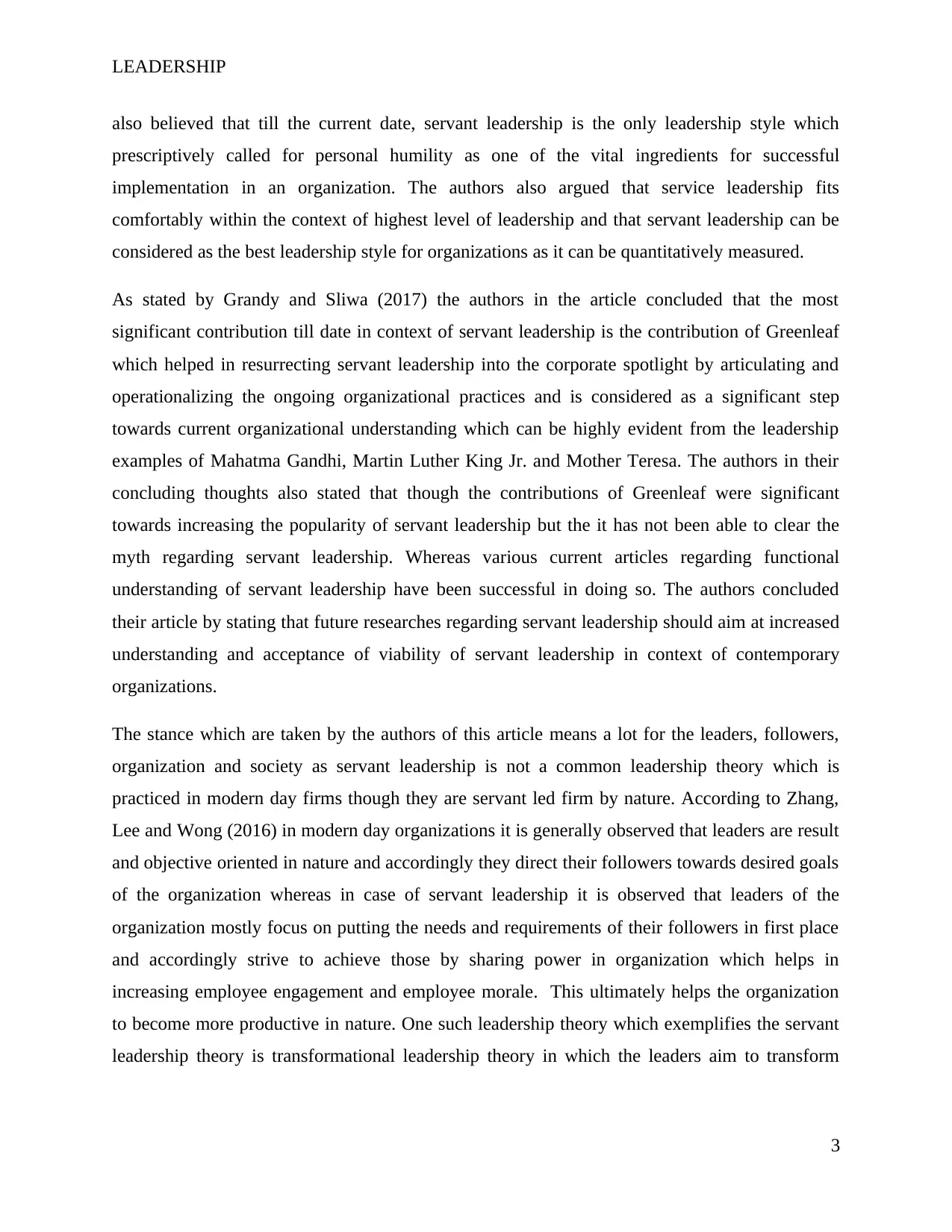
LEADERSHIP
also believed that till the current date, servant leadership is the only leadership style which
prescriptively called for personal humility as one of the vital ingredients for successful
implementation in an organization. The authors also argued that service leadership fits
comfortably within the context of highest level of leadership and that servant leadership can be
considered as the best leadership style for organizations as it can be quantitatively measured.
As stated by Grandy and Sliwa (2017) the authors in the article concluded that the most
significant contribution till date in context of servant leadership is the contribution of Greenleaf
which helped in resurrecting servant leadership into the corporate spotlight by articulating and
operationalizing the ongoing organizational practices and is considered as a significant step
towards current organizational understanding which can be highly evident from the leadership
examples of Mahatma Gandhi, Martin Luther King Jr. and Mother Teresa. The authors in their
concluding thoughts also stated that though the contributions of Greenleaf were significant
towards increasing the popularity of servant leadership but the it has not been able to clear the
myth regarding servant leadership. Whereas various current articles regarding functional
understanding of servant leadership have been successful in doing so. The authors concluded
their article by stating that future researches regarding servant leadership should aim at increased
understanding and acceptance of viability of servant leadership in context of contemporary
organizations.
The stance which are taken by the authors of this article means a lot for the leaders, followers,
organization and society as servant leadership is not a common leadership theory which is
practiced in modern day firms though they are servant led firm by nature. According to Zhang,
Lee and Wong (2016) in modern day organizations it is generally observed that leaders are result
and objective oriented in nature and accordingly they direct their followers towards desired goals
of the organization whereas in case of servant leadership it is observed that leaders of the
organization mostly focus on putting the needs and requirements of their followers in first place
and accordingly strive to achieve those by sharing power in organization which helps in
increasing employee engagement and employee morale. This ultimately helps the organization
to become more productive in nature. One such leadership theory which exemplifies the servant
leadership theory is transformational leadership theory in which the leaders aim to transform
3
also believed that till the current date, servant leadership is the only leadership style which
prescriptively called for personal humility as one of the vital ingredients for successful
implementation in an organization. The authors also argued that service leadership fits
comfortably within the context of highest level of leadership and that servant leadership can be
considered as the best leadership style for organizations as it can be quantitatively measured.
As stated by Grandy and Sliwa (2017) the authors in the article concluded that the most
significant contribution till date in context of servant leadership is the contribution of Greenleaf
which helped in resurrecting servant leadership into the corporate spotlight by articulating and
operationalizing the ongoing organizational practices and is considered as a significant step
towards current organizational understanding which can be highly evident from the leadership
examples of Mahatma Gandhi, Martin Luther King Jr. and Mother Teresa. The authors in their
concluding thoughts also stated that though the contributions of Greenleaf were significant
towards increasing the popularity of servant leadership but the it has not been able to clear the
myth regarding servant leadership. Whereas various current articles regarding functional
understanding of servant leadership have been successful in doing so. The authors concluded
their article by stating that future researches regarding servant leadership should aim at increased
understanding and acceptance of viability of servant leadership in context of contemporary
organizations.
The stance which are taken by the authors of this article means a lot for the leaders, followers,
organization and society as servant leadership is not a common leadership theory which is
practiced in modern day firms though they are servant led firm by nature. According to Zhang,
Lee and Wong (2016) in modern day organizations it is generally observed that leaders are result
and objective oriented in nature and accordingly they direct their followers towards desired goals
of the organization whereas in case of servant leadership it is observed that leaders of the
organization mostly focus on putting the needs and requirements of their followers in first place
and accordingly strive to achieve those by sharing power in organization which helps in
increasing employee engagement and employee morale. This ultimately helps the organization
to become more productive in nature. One such leadership theory which exemplifies the servant
leadership theory is transformational leadership theory in which the leaders aim to transform
3
Paraphrase This Document
Need a fresh take? Get an instant paraphrase of this document with our AI Paraphraser
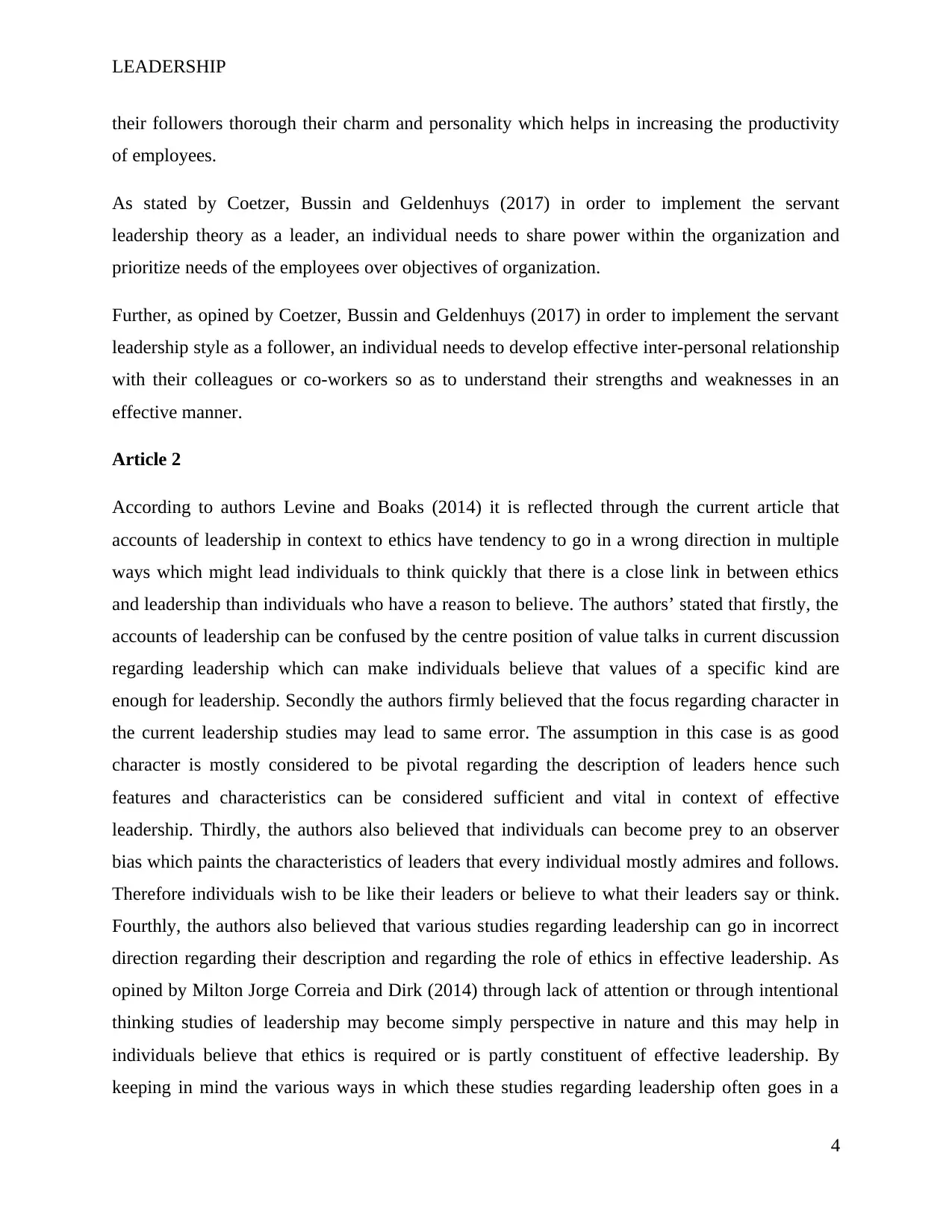
LEADERSHIP
their followers thorough their charm and personality which helps in increasing the productivity
of employees.
As stated by Coetzer, Bussin and Geldenhuys (2017) in order to implement the servant
leadership theory as a leader, an individual needs to share power within the organization and
prioritize needs of the employees over objectives of organization.
Further, as opined by Coetzer, Bussin and Geldenhuys (2017) in order to implement the servant
leadership style as a follower, an individual needs to develop effective inter-personal relationship
with their colleagues or co-workers so as to understand their strengths and weaknesses in an
effective manner.
Article 2
According to authors Levine and Boaks (2014) it is reflected through the current article that
accounts of leadership in context to ethics have tendency to go in a wrong direction in multiple
ways which might lead individuals to think quickly that there is a close link in between ethics
and leadership than individuals who have a reason to believe. The authors’ stated that firstly, the
accounts of leadership can be confused by the centre position of value talks in current discussion
regarding leadership which can make individuals believe that values of a specific kind are
enough for leadership. Secondly the authors firmly believed that the focus regarding character in
the current leadership studies may lead to same error. The assumption in this case is as good
character is mostly considered to be pivotal regarding the description of leaders hence such
features and characteristics can be considered sufficient and vital in context of effective
leadership. Thirdly, the authors also believed that individuals can become prey to an observer
bias which paints the characteristics of leaders that every individual mostly admires and follows.
Therefore individuals wish to be like their leaders or believe to what their leaders say or think.
Fourthly, the authors also believed that various studies regarding leadership can go in incorrect
direction regarding their description and regarding the role of ethics in effective leadership. As
opined by Milton Jorge Correia and Dirk (2014) through lack of attention or through intentional
thinking studies of leadership may become simply perspective in nature and this may help in
individuals believe that ethics is required or is partly constituent of effective leadership. By
keeping in mind the various ways in which these studies regarding leadership often goes in a
4
their followers thorough their charm and personality which helps in increasing the productivity
of employees.
As stated by Coetzer, Bussin and Geldenhuys (2017) in order to implement the servant
leadership theory as a leader, an individual needs to share power within the organization and
prioritize needs of the employees over objectives of organization.
Further, as opined by Coetzer, Bussin and Geldenhuys (2017) in order to implement the servant
leadership style as a follower, an individual needs to develop effective inter-personal relationship
with their colleagues or co-workers so as to understand their strengths and weaknesses in an
effective manner.
Article 2
According to authors Levine and Boaks (2014) it is reflected through the current article that
accounts of leadership in context to ethics have tendency to go in a wrong direction in multiple
ways which might lead individuals to think quickly that there is a close link in between ethics
and leadership than individuals who have a reason to believe. The authors’ stated that firstly, the
accounts of leadership can be confused by the centre position of value talks in current discussion
regarding leadership which can make individuals believe that values of a specific kind are
enough for leadership. Secondly the authors firmly believed that the focus regarding character in
the current leadership studies may lead to same error. The assumption in this case is as good
character is mostly considered to be pivotal regarding the description of leaders hence such
features and characteristics can be considered sufficient and vital in context of effective
leadership. Thirdly, the authors also believed that individuals can become prey to an observer
bias which paints the characteristics of leaders that every individual mostly admires and follows.
Therefore individuals wish to be like their leaders or believe to what their leaders say or think.
Fourthly, the authors also believed that various studies regarding leadership can go in incorrect
direction regarding their description and regarding the role of ethics in effective leadership. As
opined by Milton Jorge Correia and Dirk (2014) through lack of attention or through intentional
thinking studies of leadership may become simply perspective in nature and this may help in
individuals believe that ethics is required or is partly constituent of effective leadership. By
keeping in mind the various ways in which these studies regarding leadership often goes in a
4
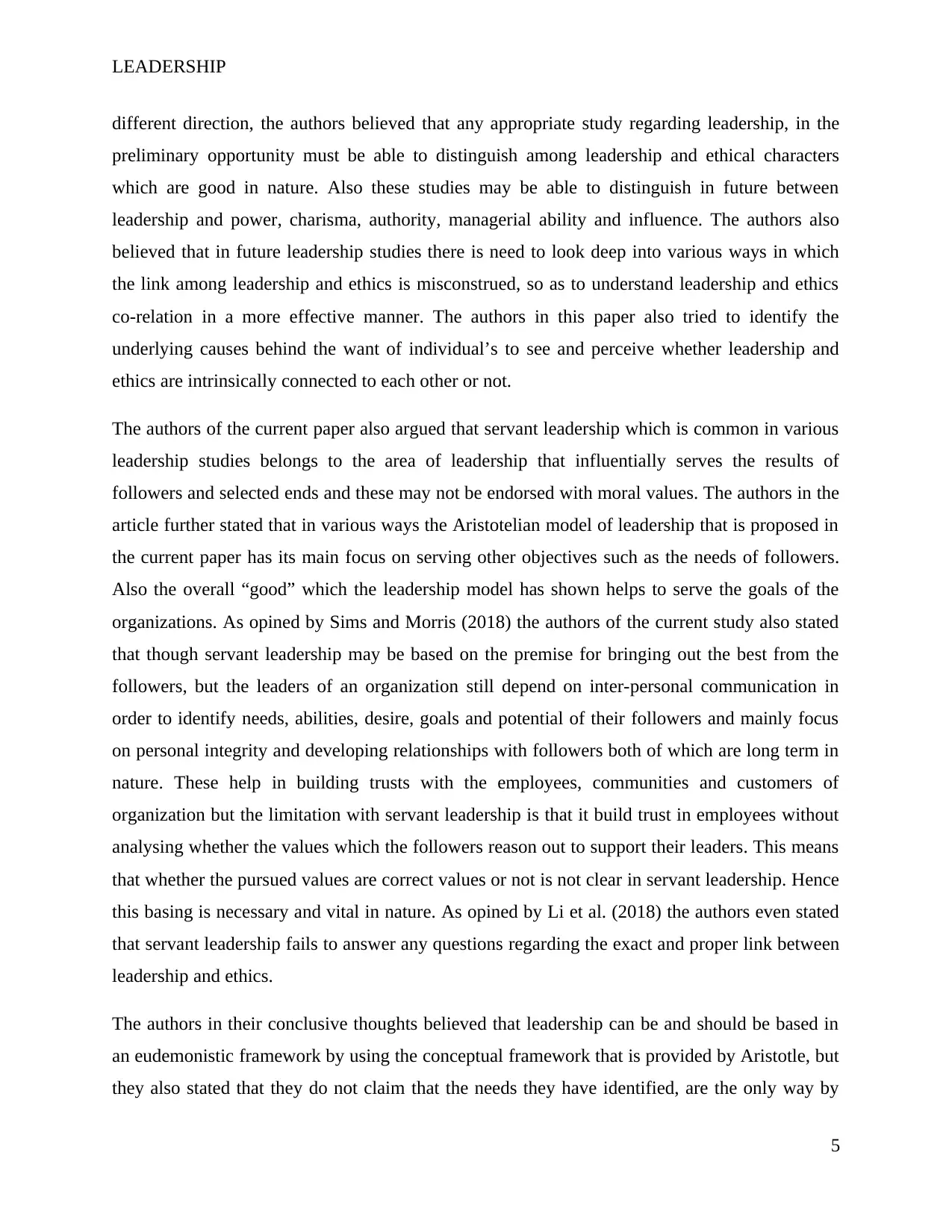
LEADERSHIP
different direction, the authors believed that any appropriate study regarding leadership, in the
preliminary opportunity must be able to distinguish among leadership and ethical characters
which are good in nature. Also these studies may be able to distinguish in future between
leadership and power, charisma, authority, managerial ability and influence. The authors also
believed that in future leadership studies there is need to look deep into various ways in which
the link among leadership and ethics is misconstrued, so as to understand leadership and ethics
co-relation in a more effective manner. The authors in this paper also tried to identify the
underlying causes behind the want of individual’s to see and perceive whether leadership and
ethics are intrinsically connected to each other or not.
The authors of the current paper also argued that servant leadership which is common in various
leadership studies belongs to the area of leadership that influentially serves the results of
followers and selected ends and these may not be endorsed with moral values. The authors in the
article further stated that in various ways the Aristotelian model of leadership that is proposed in
the current paper has its main focus on serving other objectives such as the needs of followers.
Also the overall “good” which the leadership model has shown helps to serve the goals of the
organizations. As opined by Sims and Morris (2018) the authors of the current study also stated
that though servant leadership may be based on the premise for bringing out the best from the
followers, but the leaders of an organization still depend on inter-personal communication in
order to identify needs, abilities, desire, goals and potential of their followers and mainly focus
on personal integrity and developing relationships with followers both of which are long term in
nature. These help in building trusts with the employees, communities and customers of
organization but the limitation with servant leadership is that it build trust in employees without
analysing whether the values which the followers reason out to support their leaders. This means
that whether the pursued values are correct values or not is not clear in servant leadership. Hence
this basing is necessary and vital in nature. As opined by Li et al. (2018) the authors even stated
that servant leadership fails to answer any questions regarding the exact and proper link between
leadership and ethics.
The authors in their conclusive thoughts believed that leadership can be and should be based in
an eudemonistic framework by using the conceptual framework that is provided by Aristotle, but
they also stated that they do not claim that the needs they have identified, are the only way by
5
different direction, the authors believed that any appropriate study regarding leadership, in the
preliminary opportunity must be able to distinguish among leadership and ethical characters
which are good in nature. Also these studies may be able to distinguish in future between
leadership and power, charisma, authority, managerial ability and influence. The authors also
believed that in future leadership studies there is need to look deep into various ways in which
the link among leadership and ethics is misconstrued, so as to understand leadership and ethics
co-relation in a more effective manner. The authors in this paper also tried to identify the
underlying causes behind the want of individual’s to see and perceive whether leadership and
ethics are intrinsically connected to each other or not.
The authors of the current paper also argued that servant leadership which is common in various
leadership studies belongs to the area of leadership that influentially serves the results of
followers and selected ends and these may not be endorsed with moral values. The authors in the
article further stated that in various ways the Aristotelian model of leadership that is proposed in
the current paper has its main focus on serving other objectives such as the needs of followers.
Also the overall “good” which the leadership model has shown helps to serve the goals of the
organizations. As opined by Sims and Morris (2018) the authors of the current study also stated
that though servant leadership may be based on the premise for bringing out the best from the
followers, but the leaders of an organization still depend on inter-personal communication in
order to identify needs, abilities, desire, goals and potential of their followers and mainly focus
on personal integrity and developing relationships with followers both of which are long term in
nature. These help in building trusts with the employees, communities and customers of
organization but the limitation with servant leadership is that it build trust in employees without
analysing whether the values which the followers reason out to support their leaders. This means
that whether the pursued values are correct values or not is not clear in servant leadership. Hence
this basing is necessary and vital in nature. As opined by Li et al. (2018) the authors even stated
that servant leadership fails to answer any questions regarding the exact and proper link between
leadership and ethics.
The authors in their conclusive thoughts believed that leadership can be and should be based in
an eudemonistic framework by using the conceptual framework that is provided by Aristotle, but
they also stated that they do not claim that the needs they have identified, are the only way by
5
⊘ This is a preview!⊘
Do you want full access?
Subscribe today to unlock all pages.

Trusted by 1+ million students worldwide
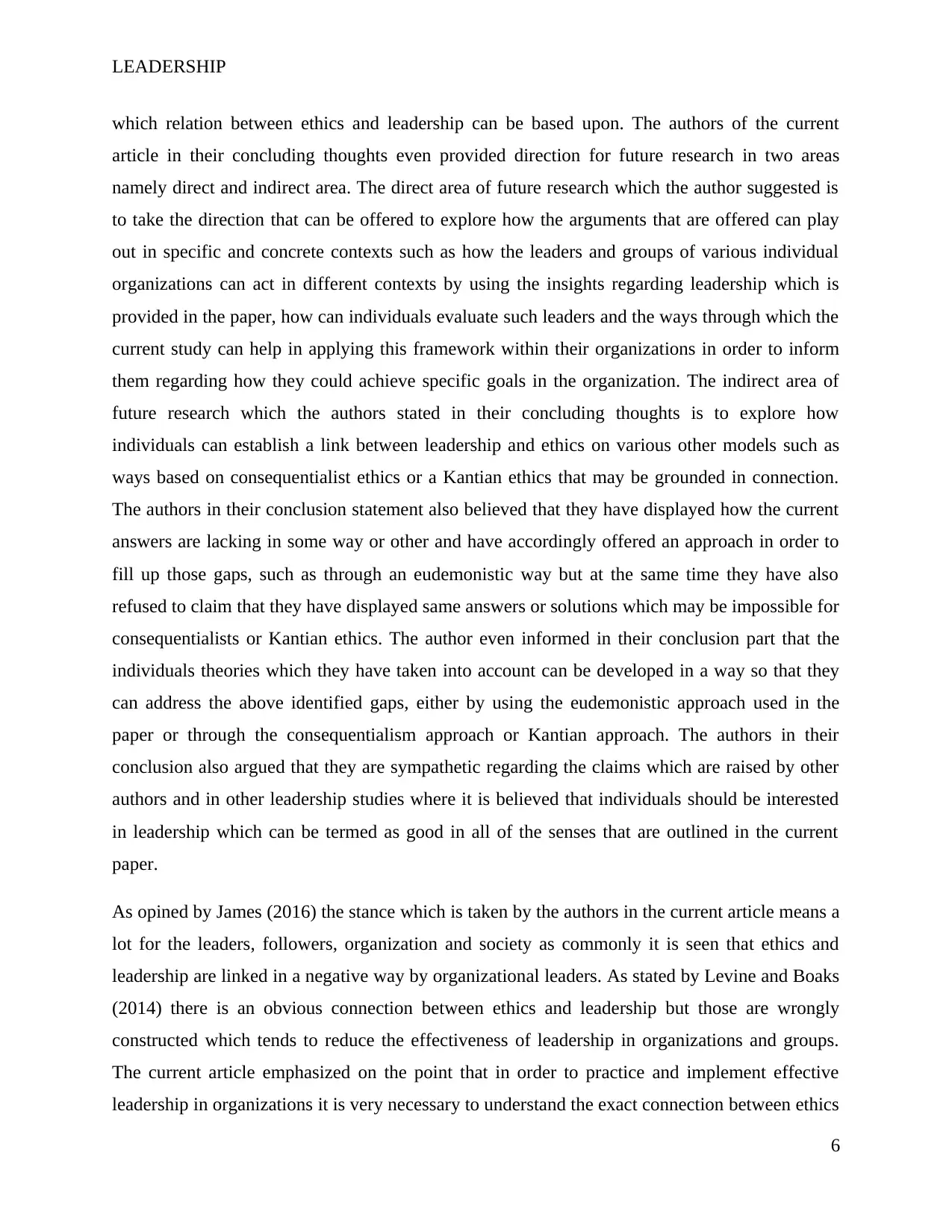
LEADERSHIP
which relation between ethics and leadership can be based upon. The authors of the current
article in their concluding thoughts even provided direction for future research in two areas
namely direct and indirect area. The direct area of future research which the author suggested is
to take the direction that can be offered to explore how the arguments that are offered can play
out in specific and concrete contexts such as how the leaders and groups of various individual
organizations can act in different contexts by using the insights regarding leadership which is
provided in the paper, how can individuals evaluate such leaders and the ways through which the
current study can help in applying this framework within their organizations in order to inform
them regarding how they could achieve specific goals in the organization. The indirect area of
future research which the authors stated in their concluding thoughts is to explore how
individuals can establish a link between leadership and ethics on various other models such as
ways based on consequentialist ethics or a Kantian ethics that may be grounded in connection.
The authors in their conclusion statement also believed that they have displayed how the current
answers are lacking in some way or other and have accordingly offered an approach in order to
fill up those gaps, such as through an eudemonistic way but at the same time they have also
refused to claim that they have displayed same answers or solutions which may be impossible for
consequentialists or Kantian ethics. The author even informed in their conclusion part that the
individuals theories which they have taken into account can be developed in a way so that they
can address the above identified gaps, either by using the eudemonistic approach used in the
paper or through the consequentialism approach or Kantian approach. The authors in their
conclusion also argued that they are sympathetic regarding the claims which are raised by other
authors and in other leadership studies where it is believed that individuals should be interested
in leadership which can be termed as good in all of the senses that are outlined in the current
paper.
As opined by James (2016) the stance which is taken by the authors in the current article means a
lot for the leaders, followers, organization and society as commonly it is seen that ethics and
leadership are linked in a negative way by organizational leaders. As stated by Levine and Boaks
(2014) there is an obvious connection between ethics and leadership but those are wrongly
constructed which tends to reduce the effectiveness of leadership in organizations and groups.
The current article emphasized on the point that in order to practice and implement effective
leadership in organizations it is very necessary to understand the exact connection between ethics
6
which relation between ethics and leadership can be based upon. The authors of the current
article in their concluding thoughts even provided direction for future research in two areas
namely direct and indirect area. The direct area of future research which the author suggested is
to take the direction that can be offered to explore how the arguments that are offered can play
out in specific and concrete contexts such as how the leaders and groups of various individual
organizations can act in different contexts by using the insights regarding leadership which is
provided in the paper, how can individuals evaluate such leaders and the ways through which the
current study can help in applying this framework within their organizations in order to inform
them regarding how they could achieve specific goals in the organization. The indirect area of
future research which the authors stated in their concluding thoughts is to explore how
individuals can establish a link between leadership and ethics on various other models such as
ways based on consequentialist ethics or a Kantian ethics that may be grounded in connection.
The authors in their conclusion statement also believed that they have displayed how the current
answers are lacking in some way or other and have accordingly offered an approach in order to
fill up those gaps, such as through an eudemonistic way but at the same time they have also
refused to claim that they have displayed same answers or solutions which may be impossible for
consequentialists or Kantian ethics. The author even informed in their conclusion part that the
individuals theories which they have taken into account can be developed in a way so that they
can address the above identified gaps, either by using the eudemonistic approach used in the
paper or through the consequentialism approach or Kantian approach. The authors in their
conclusion also argued that they are sympathetic regarding the claims which are raised by other
authors and in other leadership studies where it is believed that individuals should be interested
in leadership which can be termed as good in all of the senses that are outlined in the current
paper.
As opined by James (2016) the stance which is taken by the authors in the current article means a
lot for the leaders, followers, organization and society as commonly it is seen that ethics and
leadership are linked in a negative way by organizational leaders. As stated by Levine and Boaks
(2014) there is an obvious connection between ethics and leadership but those are wrongly
constructed which tends to reduce the effectiveness of leadership in organizations and groups.
The current article emphasized on the point that in order to practice and implement effective
leadership in organizations it is very necessary to understand the exact connection between ethics
6
Paraphrase This Document
Need a fresh take? Get an instant paraphrase of this document with our AI Paraphraser
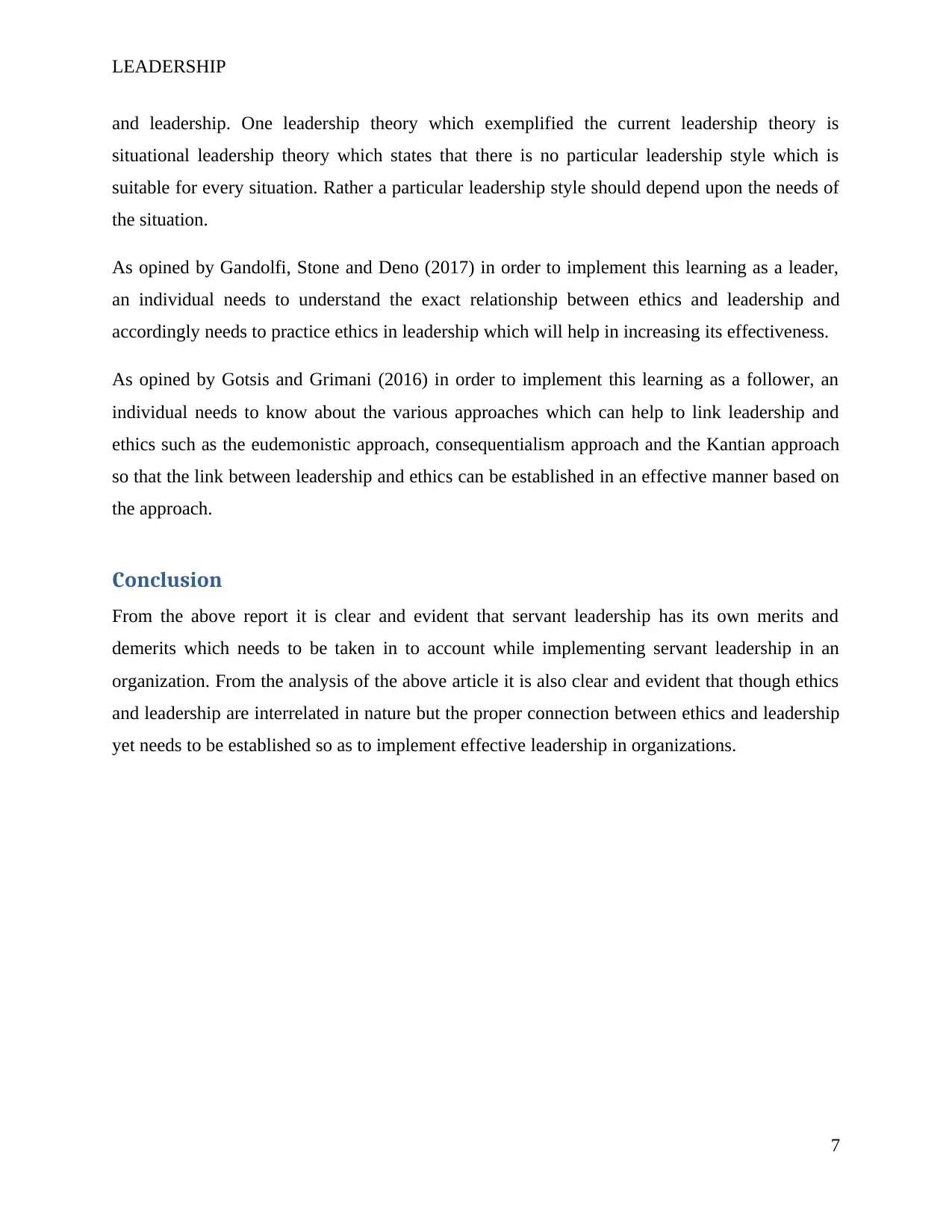
LEADERSHIP
and leadership. One leadership theory which exemplified the current leadership theory is
situational leadership theory which states that there is no particular leadership style which is
suitable for every situation. Rather a particular leadership style should depend upon the needs of
the situation.
As opined by Gandolfi, Stone and Deno (2017) in order to implement this learning as a leader,
an individual needs to understand the exact relationship between ethics and leadership and
accordingly needs to practice ethics in leadership which will help in increasing its effectiveness.
As opined by Gotsis and Grimani (2016) in order to implement this learning as a follower, an
individual needs to know about the various approaches which can help to link leadership and
ethics such as the eudemonistic approach, consequentialism approach and the Kantian approach
so that the link between leadership and ethics can be established in an effective manner based on
the approach.
Conclusion
From the above report it is clear and evident that servant leadership has its own merits and
demerits which needs to be taken in to account while implementing servant leadership in an
organization. From the analysis of the above article it is also clear and evident that though ethics
and leadership are interrelated in nature but the proper connection between ethics and leadership
yet needs to be established so as to implement effective leadership in organizations.
7
and leadership. One leadership theory which exemplified the current leadership theory is
situational leadership theory which states that there is no particular leadership style which is
suitable for every situation. Rather a particular leadership style should depend upon the needs of
the situation.
As opined by Gandolfi, Stone and Deno (2017) in order to implement this learning as a leader,
an individual needs to understand the exact relationship between ethics and leadership and
accordingly needs to practice ethics in leadership which will help in increasing its effectiveness.
As opined by Gotsis and Grimani (2016) in order to implement this learning as a follower, an
individual needs to know about the various approaches which can help to link leadership and
ethics such as the eudemonistic approach, consequentialism approach and the Kantian approach
so that the link between leadership and ethics can be established in an effective manner based on
the approach.
Conclusion
From the above report it is clear and evident that servant leadership has its own merits and
demerits which needs to be taken in to account while implementing servant leadership in an
organization. From the analysis of the above article it is also clear and evident that though ethics
and leadership are interrelated in nature but the proper connection between ethics and leadership
yet needs to be established so as to implement effective leadership in organizations.
7
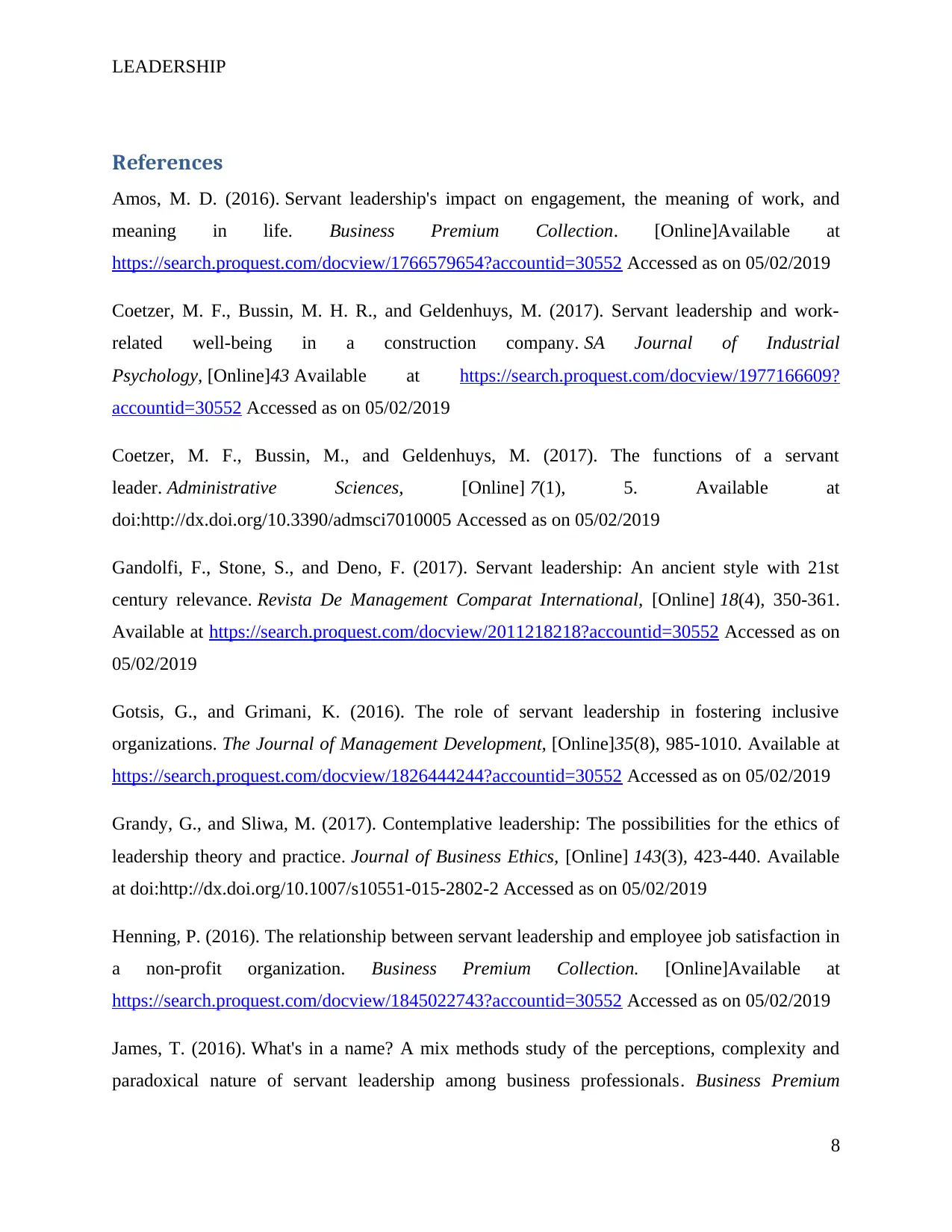
LEADERSHIP
References
Amos, M. D. (2016). Servant leadership's impact on engagement, the meaning of work, and
meaning in life. Business Premium Collection. [Online]Available at
https://search.proquest.com/docview/1766579654?accountid=30552 Accessed as on 05/02/2019
Coetzer, M. F., Bussin, M. H. R., and Geldenhuys, M. (2017). Servant leadership and work-
related well-being in a construction company. SA Journal of Industrial
Psychology, [Online]43 Available at https://search.proquest.com/docview/1977166609?
accountid=30552 Accessed as on 05/02/2019
Coetzer, M. F., Bussin, M., and Geldenhuys, M. (2017). The functions of a servant
leader. Administrative Sciences, [Online] 7(1), 5. Available at
doi:http://dx.doi.org/10.3390/admsci7010005 Accessed as on 05/02/2019
Gandolfi, F., Stone, S., and Deno, F. (2017). Servant leadership: An ancient style with 21st
century relevance. Revista De Management Comparat International, [Online] 18(4), 350-361.
Available at https://search.proquest.com/docview/2011218218?accountid=30552 Accessed as on
05/02/2019
Gotsis, G., and Grimani, K. (2016). The role of servant leadership in fostering inclusive
organizations. The Journal of Management Development, [Online]35(8), 985-1010. Available at
https://search.proquest.com/docview/1826444244?accountid=30552 Accessed as on 05/02/2019
Grandy, G., and Sliwa, M. (2017). Contemplative leadership: The possibilities for the ethics of
leadership theory and practice. Journal of Business Ethics, [Online] 143(3), 423-440. Available
at doi:http://dx.doi.org/10.1007/s10551-015-2802-2 Accessed as on 05/02/2019
Henning, P. (2016). The relationship between servant leadership and employee job satisfaction in
a non-profit organization. Business Premium Collection. [Online]Available at
https://search.proquest.com/docview/1845022743?accountid=30552 Accessed as on 05/02/2019
James, T. (2016). What's in a name? A mix methods study of the perceptions, complexity and
paradoxical nature of servant leadership among business professionals. Business Premium
8
References
Amos, M. D. (2016). Servant leadership's impact on engagement, the meaning of work, and
meaning in life. Business Premium Collection. [Online]Available at
https://search.proquest.com/docview/1766579654?accountid=30552 Accessed as on 05/02/2019
Coetzer, M. F., Bussin, M. H. R., and Geldenhuys, M. (2017). Servant leadership and work-
related well-being in a construction company. SA Journal of Industrial
Psychology, [Online]43 Available at https://search.proquest.com/docview/1977166609?
accountid=30552 Accessed as on 05/02/2019
Coetzer, M. F., Bussin, M., and Geldenhuys, M. (2017). The functions of a servant
leader. Administrative Sciences, [Online] 7(1), 5. Available at
doi:http://dx.doi.org/10.3390/admsci7010005 Accessed as on 05/02/2019
Gandolfi, F., Stone, S., and Deno, F. (2017). Servant leadership: An ancient style with 21st
century relevance. Revista De Management Comparat International, [Online] 18(4), 350-361.
Available at https://search.proquest.com/docview/2011218218?accountid=30552 Accessed as on
05/02/2019
Gotsis, G., and Grimani, K. (2016). The role of servant leadership in fostering inclusive
organizations. The Journal of Management Development, [Online]35(8), 985-1010. Available at
https://search.proquest.com/docview/1826444244?accountid=30552 Accessed as on 05/02/2019
Grandy, G., and Sliwa, M. (2017). Contemplative leadership: The possibilities for the ethics of
leadership theory and practice. Journal of Business Ethics, [Online] 143(3), 423-440. Available
at doi:http://dx.doi.org/10.1007/s10551-015-2802-2 Accessed as on 05/02/2019
Henning, P. (2016). The relationship between servant leadership and employee job satisfaction in
a non-profit organization. Business Premium Collection. [Online]Available at
https://search.proquest.com/docview/1845022743?accountid=30552 Accessed as on 05/02/2019
James, T. (2016). What's in a name? A mix methods study of the perceptions, complexity and
paradoxical nature of servant leadership among business professionals. Business Premium
8
⊘ This is a preview!⊘
Do you want full access?
Subscribe today to unlock all pages.

Trusted by 1+ million students worldwide
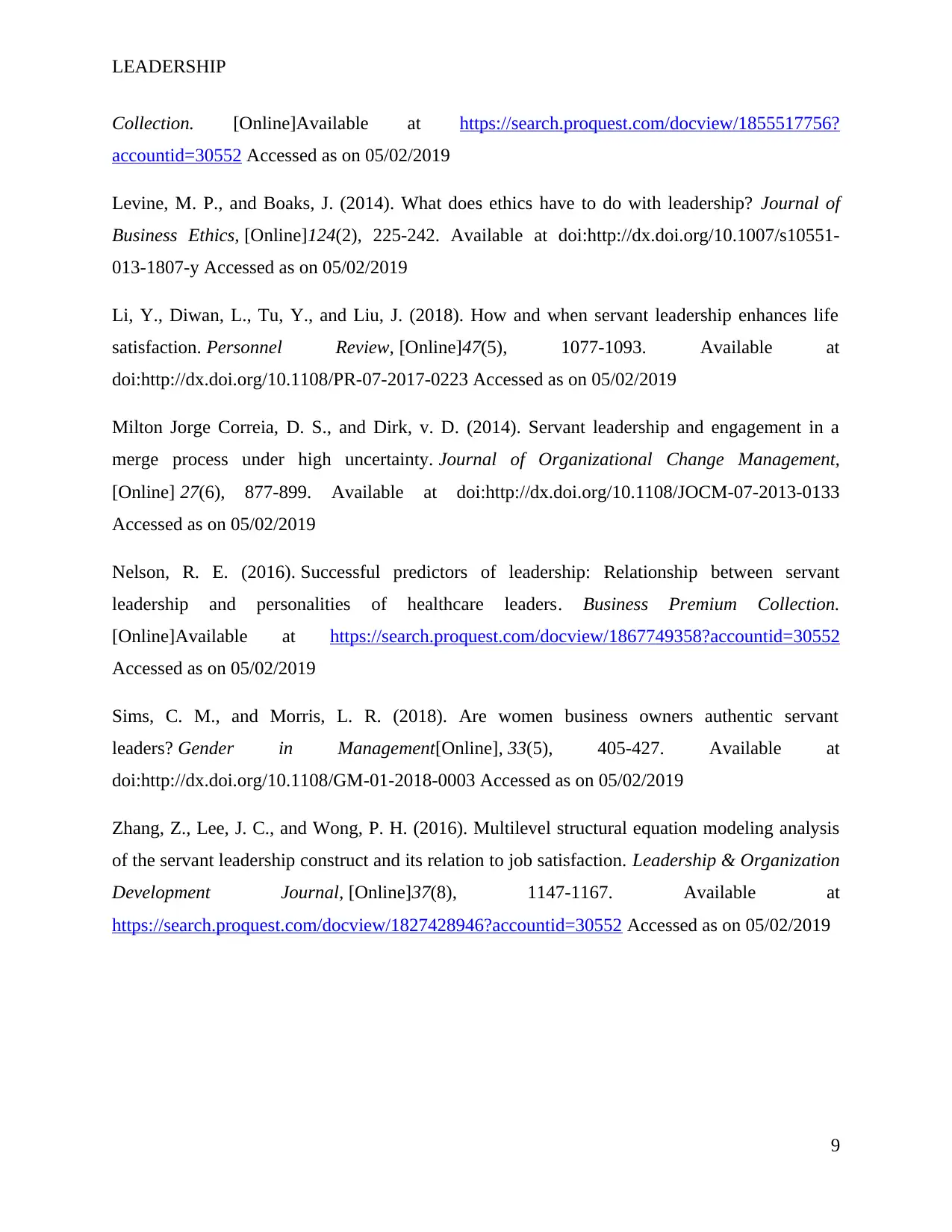
LEADERSHIP
Collection. [Online]Available at https://search.proquest.com/docview/1855517756?
accountid=30552 Accessed as on 05/02/2019
Levine, M. P., and Boaks, J. (2014). What does ethics have to do with leadership? Journal of
Business Ethics, [Online]124(2), 225-242. Available at doi:http://dx.doi.org/10.1007/s10551-
013-1807-y Accessed as on 05/02/2019
Li, Y., Diwan, L., Tu, Y., and Liu, J. (2018). How and when servant leadership enhances life
satisfaction. Personnel Review, [Online]47(5), 1077-1093. Available at
doi:http://dx.doi.org/10.1108/PR-07-2017-0223 Accessed as on 05/02/2019
Milton Jorge Correia, D. S., and Dirk, v. D. (2014). Servant leadership and engagement in a
merge process under high uncertainty. Journal of Organizational Change Management,
[Online] 27(6), 877-899. Available at doi:http://dx.doi.org/10.1108/JOCM-07-2013-0133
Accessed as on 05/02/2019
Nelson, R. E. (2016). Successful predictors of leadership: Relationship between servant
leadership and personalities of healthcare leaders. Business Premium Collection.
[Online]Available at https://search.proquest.com/docview/1867749358?accountid=30552
Accessed as on 05/02/2019
Sims, C. M., and Morris, L. R. (2018). Are women business owners authentic servant
leaders? Gender in Management[Online], 33(5), 405-427. Available at
doi:http://dx.doi.org/10.1108/GM-01-2018-0003 Accessed as on 05/02/2019
Zhang, Z., Lee, J. C., and Wong, P. H. (2016). Multilevel structural equation modeling analysis
of the servant leadership construct and its relation to job satisfaction. Leadership & Organization
Development Journal, [Online]37(8), 1147-1167. Available at
https://search.proquest.com/docview/1827428946?accountid=30552 Accessed as on 05/02/2019
9
Collection. [Online]Available at https://search.proquest.com/docview/1855517756?
accountid=30552 Accessed as on 05/02/2019
Levine, M. P., and Boaks, J. (2014). What does ethics have to do with leadership? Journal of
Business Ethics, [Online]124(2), 225-242. Available at doi:http://dx.doi.org/10.1007/s10551-
013-1807-y Accessed as on 05/02/2019
Li, Y., Diwan, L., Tu, Y., and Liu, J. (2018). How and when servant leadership enhances life
satisfaction. Personnel Review, [Online]47(5), 1077-1093. Available at
doi:http://dx.doi.org/10.1108/PR-07-2017-0223 Accessed as on 05/02/2019
Milton Jorge Correia, D. S., and Dirk, v. D. (2014). Servant leadership and engagement in a
merge process under high uncertainty. Journal of Organizational Change Management,
[Online] 27(6), 877-899. Available at doi:http://dx.doi.org/10.1108/JOCM-07-2013-0133
Accessed as on 05/02/2019
Nelson, R. E. (2016). Successful predictors of leadership: Relationship between servant
leadership and personalities of healthcare leaders. Business Premium Collection.
[Online]Available at https://search.proquest.com/docview/1867749358?accountid=30552
Accessed as on 05/02/2019
Sims, C. M., and Morris, L. R. (2018). Are women business owners authentic servant
leaders? Gender in Management[Online], 33(5), 405-427. Available at
doi:http://dx.doi.org/10.1108/GM-01-2018-0003 Accessed as on 05/02/2019
Zhang, Z., Lee, J. C., and Wong, P. H. (2016). Multilevel structural equation modeling analysis
of the servant leadership construct and its relation to job satisfaction. Leadership & Organization
Development Journal, [Online]37(8), 1147-1167. Available at
https://search.proquest.com/docview/1827428946?accountid=30552 Accessed as on 05/02/2019
9
1 out of 10
Related Documents
Your All-in-One AI-Powered Toolkit for Academic Success.
+13062052269
info@desklib.com
Available 24*7 on WhatsApp / Email
![[object Object]](/_next/static/media/star-bottom.7253800d.svg)
Unlock your academic potential
Copyright © 2020–2025 A2Z Services. All Rights Reserved. Developed and managed by ZUCOL.





